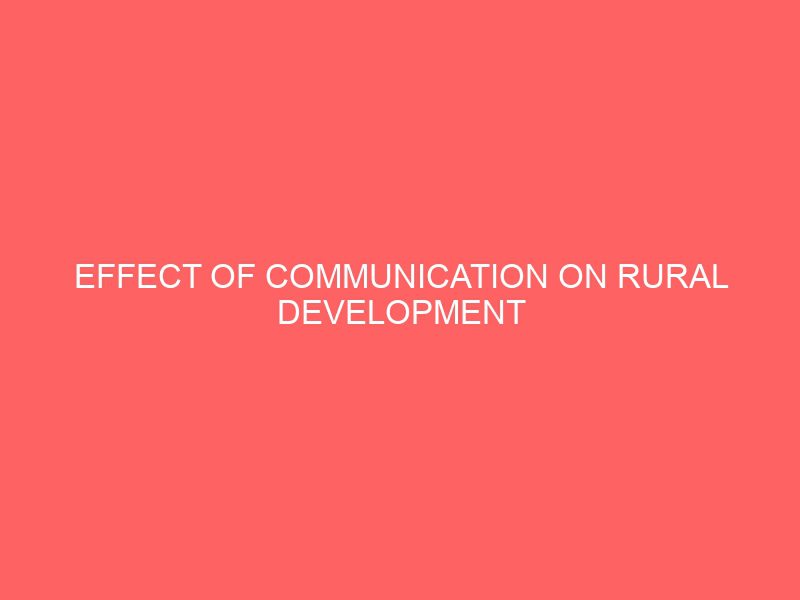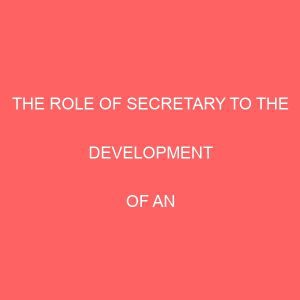Description
CHAPTER ONE
BACKGROUND TO THE STUDY
1.1 Introduction
Over the years, several projects have been initiated and implemented with the intention of bringing development to rural communities. Most of these projects are not able to achieve their intended objective of bringing development to these rural poor. It can therefore be assumed that these projects lack something that needs to fuel the development. According to the World Congress on Communication for Development (WCCD) (2006), the key to success in development initiatives is to start with the participatory analysis of the needs of local institutions and stakeholders, taking into account local culture and values, and promoting a concerted action for the development. Participatory analysis of needs of the beneficiaries can best be done with the help of communication. Communication and development has been viewed as closely intertwined phenomena, where one is believed to guarantee the other (Servaes, 2008). Communication can be a vital component of initiatives that involve voluntary behavior and change thus communication becomes important in playing advocacy role by listening, gathering data and informing. Again, communication can be used to persuade and train people through social mobilization and to help change behaviors by educating and managing change where people have options to change their ways of life (Servaes, 2008). People?s participation is sine qua non for development (Mohammad, 2010), and as Masilela the deputy Chief Executive Officer (CEO) Research of the Human Sciences Research Council (HSRC) puts it, ?if peasants do not control or share control of the processes of their own development, there can be no guarantee that it is their interest that is being served? (Ascroft and Masilela, 1994).
Modern development scholars such as Robert Chambers have been advocating people’s inclusion in development projects as they believe the stated objectives of any project cannot be fully achieved unless people meaningfully participate in it (Mefalopulos, 2003). The emphasis on participation in development also implies increased attention to communication, because there can be no participation without communication. Communication is central to this task in many ways; thus, it enables planners, when identifying and formulating development programs, to consult with people (the stakeholders) in order to take into account their needs, attitudes and traditional knowledge (Diouf, 1994).
Development communication is the only way project beneficiaries can become the principal actors to make development programmes successful (FAO, 2004). Communication for Development (ComDev) or development communication can be defined as the planned and systematic use of communication through inter-personal channels, ICTs audio-visuals and mass media for social change. Development is about change, and if development initiatives of any kind are to be sustainable they should start with mechanisms that ensure broad participation by all those who have some interest in the intended change (Mefalopolus, 2008). In ComDev, rural people are at the centre of any given development initiative and so communication is used in this sense for people?s participation and community mobilization, decision making and action, confidence building for raising awareness, sharing knowledge and changing attitudes, behaviour and lifestyles (FAO 2006). According to Adedokun et al. (2010), communication is expected to be used to facilitate community participation in a development planning initiative.
Sustenance and people?s participation has become key elements in development projects. This was acknowledged by the World Bank (1994) in its admission that: ?Internationally, emphasis is being placed on the challenge of Sustainable Development, and participation is increasingly recognized as a necessary part of Sustainable Development strategies.? To be truly significant and meaningful, participation needs to be based on the application of genuine two-way communication principles and practices (Mefalopulos, 2003).
1.2 Statement of the Problem
According to Anyanwu (1999), community development depends on the effectiveness of communication as it helps in sharing of ideas and opinions and diffusion of good ideas while irrelevant ideas are thrown out. Effective communication therefore enhances participation of community members towards the achievement of the goals of the rural community development. The newer conceptions of development imply a different and, generally, a wider role for communication (Everett Rogers, 2003). According to Stone (1989), unless people themselves are the driving force of their own development, no amount of investment or provision of technology and inputs will bring about any lasting improvements in their living standards. Most projects in the form of community boreholes, clinics, schools, warehouses and some farming projects initiated by some NGO?s and government in Ghana are in deplorable state. Most of these projects come in the form of aids or agricultural inputs such as seeds and fertilizers to the target groups without really knowing whether it would be useful for the people (Dzinavatonga, 2008). Some of these boreholes have even been abandoned. This may be as a result of some measures which were not put in place to ensure the sustenance of the projects after the implementers have left. These measures among other things may include the fact that the communities were not involved wholly in the formulation and implementation of these projects to understand the need to own and sustain them.
Too many development programs, including community-driven ones, seem to overlook the aspect of communication, which is intended as the professional use of dialogic methods and tools to promote change (Mefalopulos, 2008). According to Okafor (2005) when communities participate in their own projects they become empowered which in turns improve efficiency, transparency and accountability which enhances service delivery and also encourages donor?s harmonization. Again, when not involved from the beginning, stakeholders tend to be more suspicious of project activities and less prone to support them. Conversely, when communication is used to involve them in the definition of an initiative, their motivation and commitment grow stronger (Okafor, 2005).
1.3 Research Questions
i. How does communication influence rural development?
ii. What communication channel is used by development agencies and government during projects implementation in The Punch newspaper?
iii. How can communication promote projects to help bring change in the lives of people living in rural areas?
1.4 Objectives of the Study
As highlighted in the foregoing sections, communication can be a key tool that can enhance community participation in decision-making concerning their own wellbeing. The main objective of this study is to determine the effect of communication on rural development while the specific objectives are;
i. To identify how communication influences rural development.
ii. To identify the communication channel used by development agencies and government during projects implementation in The Punch newspaper.
iii. To identify how communication can promote projects to help bring change in the lives of the people living in rural areas.
1.5 Significance of the Study
Rural people have lived together over the years and do things in common such as eating and sleeping together, going to the farms together, helping themselves when it comes to farming (Olukotun, 2008). The way their houses are even built gives room for consultation and sharing of ideas. Common things like roads, schools, health centers and bridges which are all constructed through communal labor and personal contributions are shared in rural communities. Having lived together all their lives and having shared ideas for a long period of time, it feels odd, if not unacceptable to some of them when they get to know of projects in their communities and have no idea about either its conception or implementation (Komalawati, 2008). The projects are therefore hardly accepted by the communities as their own and such projects in most cases suffer abandonment, limited usage or at best poor maintenance (Olukotun, 2008).
1.6 Scope of the Study
Communication is more than transmitting information. It entails advocacy, social mobilization and behaviour change. Mefalopulos, (2008) stated that it is about generating new knowledge and consensus in order to facilitate change. Communication is not only about raising awareness, informing, persuading, or changing behavior. It is also about listening, exploring, understanding, empowering, and building consensus for change. This study focused on how communication can be used to ensure a project?s sustenance. It again focused on sponsored projects and programmes in some communities.
1.7 Historical Background of the Study
The Punch newspaper was founded by two friends, James Aboderin, an accountant, and Sam Amuka, a columnist and editor at the Daily Times of Nigeria. Amuka became the first editor of the Sunday Punch. In November 1976, a few years after the first print of its Sunday edition, the duo started printing their trademark daily newspaper. Both editions were designed to favour a friendlier apolitical approach to news reporting, combining footage of social events with everyday political news. The paper sustains itself by delving into broad issues that interest myriad people.
However, during the twilight of the Second Republic, political exigencies had introduced conflicts to its original intentions, Aboderin and Amuka parted ways due partly to political conflicts. Aboderin later secured the support of his former foe, M. K. O. Abiola, after the latter left the NPN. The paper began to take on a political stance, mostly against the Shagari regime. Supposedly, days before the end of the administration of Shagari, a few Punch editors were aware of a coup approaching and injected strong anti-government tones in their reporting.
The Punch was not immune to the excess of authoritarian regimes in the country. In 1990, its editor was jailed for 54 days. In 1993 and 1994, the publishing house was closed on the direction of the nation’s ruler.
Punch Nigeria Limited was registered on August 8, 1970, under the Companies Act of 1968 to engage in the business of publishing newspapers, magazines and other periodicals of public interest. It was designed to perform the tripartite functions of the popular mass media: informing, educating and entertaining Nigerians and the world at large. The company has a Board of Directors, hereinafter referred to as the Board, which is the highest policy-making organ of the company.
Its policies and directives are implemented by a Management team led by the Managing Director (MD) who is the Company’s Chief Executive Officer. As a corporate business entity, the company exists to make profit and by doing so, seeks to improve the lot of its owners and employees and also contribute its quota to the country’s economic development.
In 1971, the company made its debut with the publication of HAPPY HOME, a glossy family-oriented magazine. Its first editor was Bunmi Sofola. On Sunday, March 18, 1973, its first weekly newspaper, Sunday PUNCH, hit the newsstands. Edited by Ajibade Fashina-Thomas. THE PUNCH, a daily tabloid followed on November 1, 1976. Its pioneer editor was Dayo Wright. However, by the 1980s, the two tabloids had been repackaged.
On April 29, 1990, a week after an attempted coup d’tat against the Federal Military Government, the company was closed down. The closure lasted a month while the then Deputy Editor of THE PUNCH, Chris Mammah, was detained for 54 days. Again in July 1993, The Federal Military Government shut the company’s premises, vide Decree No 48 of 1993, and banned all its publications from circulating in the country. The closure followed the political crisis caused by annulment of June 12, 1993, Presidential election.
On November 17 of the same year, the proscription order was repealed vide the Decree No 115 of 1993. The Federal Military Government struck on the July 24, 1994, and proscribed all the titles including TOPLIFE, which had been revived and published as a weekly magazine then. The then editor of THE PUNCH, Bola Bolawole, was detained for three days in his office in the old building. During the closure, the government ignored a court order that it should vacate the premises of the company and also pay the sum of N25 million and N100, 000.00 respectively to the company and Bolawole. It was not until October 1, 1995 that government de-proscribed the publication vide a national day broadcast by the Head of State. In spite of all these, the company has pledged not to abdicate its responsibilities to the country. The current Chairman of the Board of Directors, Chief Ajibola Ogunshola, had on March 22, 1996, at the first Victor Adebamgbe Memorial lecture assured that “the company would continue to emphasize the emergence of a free democratic Nigeria with equal opportunities for its entire citizen and all the constituent ethnic groups”.
For two consecutive years – 1998 and 1999 – the research and marketing services (RMS) Lagos, published independent surveys in which PUNCH was rated as the most widely – read newspaper.
Introduced in 1963, the Goss community began life as a single unit sitting on top of a reel stand. At that time it had a maximum speed of 12,000cph and a cut-off 22.75ins or 578mm. In recent years, enhancement made to the Community included speed and functionality upgrades and the addition of high specification model called magnum. Today, the Community offers a range of cut-offs (546-630mm): four-high configurations; web widths up to 1,000mm and a range of jaw and rotary folder options. PUNCH’s Goss Community was delivered in November 1998. It is capable of producing 30,000(cphs). The PUNCH press, which has expandable colour units, is capable of printing eight pages of full colour and eight of spot colour at up to 48 pages.







